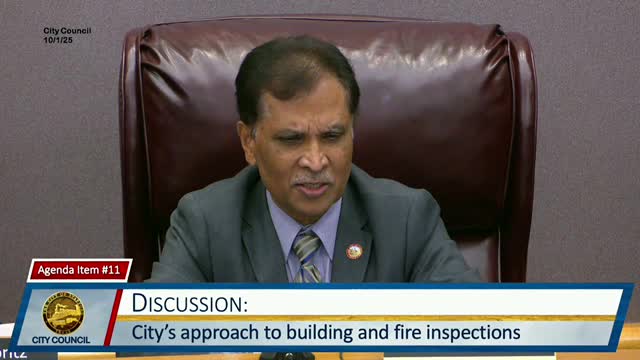City Council Discusses Revisions to Building and Fire Inspection Processes
October 01, 2025 | Stafford, Fort Bend County, Texas
This article was created by AI summarizing key points discussed. AI makes mistakes, so for full details and context, please refer to the video of the full meeting. Please report any errors so we can fix them. Report an error »

In a recent Stafford City Council meeting, officials gathered to address pressing concerns regarding the city's building and fire inspection processes. The atmosphere was charged with a sense of urgency as council members and city officials discussed the need for a more efficient and business-friendly approach to inspections that have been causing delays and frustrations for local businesses.
Council member Guerra opened the discussion by emphasizing the importance of timely inspections and the need for clear communication between inspectors and business owners. He highlighted that delays in the inspection process not only hinder business operations but also impact the city’s revenue from taxes. Guerra called for a workshop with the new fire chief to explore ways to streamline the inspection process, suggesting that a more collaborative approach could alleviate the burdens faced by business owners.
The fire chief responded, noting that recent efforts have already led to an increase in inspections—from 55 in September of the previous year to 95 this year. This uptick indicates a proactive approach to addressing inspection failures, particularly concerning fire alarm and sprinkler systems. However, he acknowledged that existing city ordinances, particularly those requiring automatic sprinkler systems in larger buildings, have created challenges for business owners looking to renovate or occupy older structures.
A significant point of contention arose around the city’s requirement that any building over 7,500 square feet must have a sprinkler system installed, regardless of the extent of renovations. This regulation has led to confusion and frustration among business owners, many of whom feel that they are being penalized for making minor changes. The fire chief proposed revising these requirements to better accommodate existing businesses while still ensuring safety.
The council members expressed a desire to find a balance between maintaining safety standards and fostering a welcoming environment for businesses. They discussed the possibility of simplifying the certificate of occupancy process, which currently requires extensive documentation even for businesses moving into spaces without making changes. Streamlining this process could allow businesses to begin operations more quickly, thus contributing to the local economy.
As the meeting concluded, there was a palpable sense of commitment among council members to work collaboratively with the fire department and local businesses. The discussions underscored the city’s recognition of the need for a more efficient inspection process that not only ensures safety but also supports the growth and sustainability of Stafford’s business community. The council's next steps will likely involve further workshops and discussions aimed at revising ordinances to create a more business-friendly environment while upholding necessary safety standards.
Council member Guerra opened the discussion by emphasizing the importance of timely inspections and the need for clear communication between inspectors and business owners. He highlighted that delays in the inspection process not only hinder business operations but also impact the city’s revenue from taxes. Guerra called for a workshop with the new fire chief to explore ways to streamline the inspection process, suggesting that a more collaborative approach could alleviate the burdens faced by business owners.
The fire chief responded, noting that recent efforts have already led to an increase in inspections—from 55 in September of the previous year to 95 this year. This uptick indicates a proactive approach to addressing inspection failures, particularly concerning fire alarm and sprinkler systems. However, he acknowledged that existing city ordinances, particularly those requiring automatic sprinkler systems in larger buildings, have created challenges for business owners looking to renovate or occupy older structures.
A significant point of contention arose around the city’s requirement that any building over 7,500 square feet must have a sprinkler system installed, regardless of the extent of renovations. This regulation has led to confusion and frustration among business owners, many of whom feel that they are being penalized for making minor changes. The fire chief proposed revising these requirements to better accommodate existing businesses while still ensuring safety.
The council members expressed a desire to find a balance between maintaining safety standards and fostering a welcoming environment for businesses. They discussed the possibility of simplifying the certificate of occupancy process, which currently requires extensive documentation even for businesses moving into spaces without making changes. Streamlining this process could allow businesses to begin operations more quickly, thus contributing to the local economy.
As the meeting concluded, there was a palpable sense of commitment among council members to work collaboratively with the fire department and local businesses. The discussions underscored the city’s recognition of the need for a more efficient inspection process that not only ensures safety but also supports the growth and sustainability of Stafford’s business community. The council's next steps will likely involve further workshops and discussions aimed at revising ordinances to create a more business-friendly environment while upholding necessary safety standards.
View full meeting
This article is based on a recent meeting—watch the full video and explore the complete transcript for deeper insights into the discussion.
View full meeting
